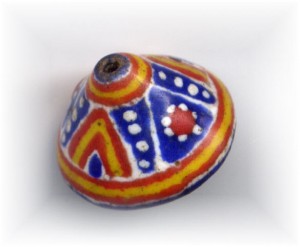African Recycled Glass Beads run the gamut of styles, shapes and sizes. But, while I’ve been using these eco-friendly African Beads in my own designs for several years, it still feels as if I’ve barely scratched the surface when it comes to the sheer variety of styles produced across the continent. Mauritanian beads are one of my most recent discoveries, and their history is every bit as fascinating as old Venetian Trade Beads!
Glass bead-making in Mauritania is commonly believed to be a relatively modern art, however, various archeological digs have uncovered evidence that type were being produced in the region as early as 1200 BCE. Bead-making in Mauritania reached its peak between the 50s and 70s when large co-operatives of women began producing Recycled Glass Beads in abundance for sale in large markets. The technique for making these beads little differs to that used for producing glass beads in Ghana; glass is ground down into a fine powder, mixed with an adhesive such as gum arabic, and fired within large, above ground kilns made of clay. They are, however, rather more ornate than Krobo Beads, often decorated with striped geometric designs and distinctive evil eyes.
Mauritania’s bead-makers produced these fascinating talismans for well over thirty years, however, the passing of an entire generation in the 1970s meant the technique was largely forgotten for several decades. Small groups of women revived the art in the 1990s, inspired no doubt by the boom in popularity of Ghanaian Recycled Glass Beads around the globe. Unfortunately, most of the replicas produced today are no match in terms of quality to the beads of old, which have since become highly collectible. You can expect to pay upwards of $100 for a traditional strand of pre-1970 Kiffa Beads – often more!
Image Credit: Kiffa Bead Cone, PSChemp/ Wikimedia.org
